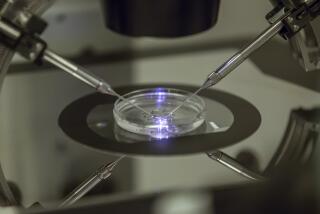A SINGULAR HOPE : The Injection of a Lone Sperm Into an Egg Can Be a Boon for Many Infertile Couples
- Share via
It was supposed to be a routine medical conference. A time to share the latest advances in helping infertile couples produce the babies they so desperately desire. No one expected any bombshells.
But, at the podium, a Belgian scientist revealed one of the most stunning developments in in-vitro fertilization since the birth of Louise Brown, the first “test-tube baby,” born in England in 1978.
A team of researchers--their work shrouded in secrecy--had taken single sperm, even the most abnormal of sperm, and injected it into the center of an egg. The procedure was producing embryos that could be implanted in a woman to produce a healthy pregnancy.
Already, the Belgian doctors said, they had achieved 100 births with the technique.
“A colleague and I were becoming giddy at what we were hearing,” says David Hill, director of the Center for Reproductive Medicine at Century City Hospital, recalling the meeting in Canada last year. “We were waiting for them to tell us they could pick up a dead sperm from the floor and manage to get fertilization.”
No one can do that yet. But this latest advance in IVF--intracytoplasmic sperm injection--is generating enthusiasm among infertility specialists who are normally reluctant to brag.
“It’s a very significant breakthrough,” says Dr. Robert Visscher, executive director of the American Fertility Society in Birmingham, Ala. “We’re talking about at least 2 million men who have severe male-factor infertility who could benefit from this.”
Like almost all advances in reproductive medicine, however, the technique raises several questions, including whether:
* birth defect rates will increase in babies born via the method;
* miscarriage will be more common among women carrying embryos conceived this way;
* the technology might be used unethically, such as to predetermine the sex of the child.
*
Sperm injection is a significant leap from traditional IVF, in which about 5 million healthy, mobile sperm are placed in a petri dish with a single egg in the hopes that one of the sperm will fertilize the egg.
The problem with traditional IVF is that up to 40% of infertile couples are affected by the “male factor”--that is, a very low sperm count, or sperm that do not move properly or are abnormally shaped. Among these men, traditional IVF often fails because the sperm cannot penetrate the egg to fertilize it.
“There really wasn’t much we could do,” Hill says. “We tried all kinds of crazy stuff and nothing led to higher birth rates.”
But options for infertile men emerged in 1992 when micromanipulation came into use. This technique uses a computerized microscope and tiny needle to maneuver the egg and sperm.
In one such technique, called subzonal injection, a concentrated drop of fluid containing sperm is placed under a microscope and five or 10 of the healthiest-looking sperm are scooped into a threadlike, hollow glass needle. The needle is used to pierce the shell of the egg, called the zona pellucida, creating an entry point for the sperm. The egg itself, however, is not touched.
Subzonal injection has helped many couples in the last two years. But several healthy sperm were still needed, and one sperm still had to penetrate the egg on its own, Hill says. And, about one-third of the time, several sperm fertilized the egg, resulting in an egg that could not develop into a normal embryo. Only one sperm can fertilize an egg for successful conception.
When this procedure failed, Hill says: “Couples were left with the options of using donor sperm or adoption.”
But single-sperm injection resolves the two problems that remain with subzonal injection: It eliminates the chance of more than one sperm penetrating the egg, and it gives another option to men whose sperm could not break into the egg.
Using this technique, the technician--called an embryologist--picks up a single sperm in the hollow glass needle and pierces the egg at just the right place, depositing the sperm into the center of the egg and withdrawing the needle carefully so the egg is not damaged.
Sperm injection is revolutionary for several reasons. In practical terms, it could help about 10% of men with male-factor infertility, Hill says.
But it also alters the scientific view of fertilization. Experts have long thought that a chemical reaction must take place when the sperm and egg meet that allows the sperm to penetrate the egg. It was also thought that the egg was too fragile to sustain a puncture into its core.
“Even the people who do this don’t understand how it works,” says Dr. Joel H. Batzofin of the Huntington Reproductive Center in Pasadena. “To take one sperm and put it right into the substance of the egg is quite a phenomenon, and it defies some of the basic understanding we had about how fertilization takes place.”
The procedure is mind-boggling in its complexity because researchers have to make the microscopic slit on the egg--which is no bigger than a grain of sand--so that the egg’s genetic material will not be damaged.
“People now say, gosh, it is doable,” Hill says. “It’s amazing how tolerant the egg is.”
The idea of injecting a sperm smack into the middle of the egg had been discussed for years, the American Fertility Society’s Visscher says. But researchers were reluctant to attempt it because of fears that it would produce babies with abnormalities.
“There was the rationale that if you bypass those natural mechanisms, you might be get an abnormal situation that might give rise to abnormal children,” Visscher says. “Also, the research on animals (using the technique) was very unsuccessful. Based on the animal work and the biological concepts, people were reluctant to get into this.”
Visscher says he thinks that it would have been impossible for American researchers to pioneer the technique because of the fear of producing babies with abnormalities. Research at major medical centers and universities has to be approved for safety and adherence to ethical standards by an unbiased committee called an institutional review board.
“I don’t think you could have gotten an institutional review board in this country to approve of the research,” Visscher says.
But since the Belgian researchers have provided ample data that the procedure is safe and useful, several U.S. infertility centers are now pursuing it without hesitation.
*
Yet questions about sperm injection remain. Among them: just how successful the procedure will be, whether the rate of birth defects will be higher among babies conceived via the method and whether the technique might be used for ethically questionable reasons, such as to select the sex of a child.
Among babies born by any of the micromanipulation techniques--about 1,000 worldwide--there is no increase in the normal rate of birth defects, Hill says. But sperm injection raises new questions about birth defects, because it is the embryologist who forces a single sperm into the egg.
Following the theory of natural selection--that the fittest survive--biologists have long thought that a sperm with defective genetic material would be less likely to fertilize an egg. Looking at a sperm through a microscope offers no way of telling if the sperm’s genetic material is healthy. (Sperm that move abnormally can still have normal genetic material.) And, even if the technician could examine a sperm’s genetic material in advance, that would raise serious ethical questions about genetic engineering: choosing the characteristics of a potential human.
“We have breached that final barrier of the egg accepting a bad sperm,” Hill says. “The babies born so far don’t show any higher rate of birth defects. But we just don’t know the long-term data yet.”
Technicians who do sperm injection have also felt the burden of what they are doing: selecting the sperm that will help make the baby.
“The principal ethical dilemma is, if you have a choice of sperm, how do you choose the one you choose?” Batzofin, of the Huntington Reproductive Center, says. “And one thing we all worry about is, what if the sperm you choose is a defective sperm?”
Another moral quandary that might arise is selecting sperm coded for a particular sex. In the future, it may be possible to determine what sex chromosome a sperm bears and, thus, predetermine the embryo’s sex.
It is also unclear just how often the procedure will produce viable pregnancies and whether the rate of miscarriage might increase because of damage to the egg or embryo. At the Brussels Free University in Belgium, where the technique was developed, eggs have been fertilized in 65% of all cases and one-third of the women who receive the embryos become pregnant. About 15% of couples who undergo one cycle of traditional IVF end up with a baby, the American Fertility Society says.
The Belgian success rate may be boosted in part by another advance in which a slit is made in the fertilized egg before it is implanted, Hill says. This slit may allow eggs with particularly tough shells to escape and attach to the wall of the uterus. Oftentimes, several embryos will be implanted but none will implant in the womb.
The dozen or so U.S. centers doing the work have not had as much success yet, partly because of a “learning curve,” Hill says. He has tried the method a few times but no pregnancies have resulted.
Batzofin has three pregnancies using sperm injection, but cautions that success rates will not be clear until centers have mastered the technique. Several other infertility specialists in Orange and Los Angeles counties are also gearing up to learn the technique.
“It’s not something where you can haphazardly inject a sperm into an egg,” Batzofin says. “It’s a difficult, meticulous procedure and it will take time to master.”
Human Fertilization Techniques
A new advance in in-vitro fertilization may help couples conceive when a man has a very low sperm count. Over 15 years of research, scientists have found ways to fertilize eggs using fewer and fewer sperm.
INTRACYTOPLASMIC SPERM INJECTION A tiny, hollow, glass needle is used to pierce the zona, the outer shell of the egg, into the very center of the egg, depositing one sperm.
SUBZONAL INJECTION The zone is pierced with a tiny, hollow glass needle and one to 15 sperm are deposited in the zona.
PARTIAL ZONA DISSECTION The zona is pierced with a tiny needle. The egg is then incubated in a droplet containing 5,000 to 10,000 sperm.
CONVENTIONAL IVF The egg is incubated in a dish containing a minimum of 50,000 and up to 5 million mobile sperm.
Source: Huntington Reproductive Center






